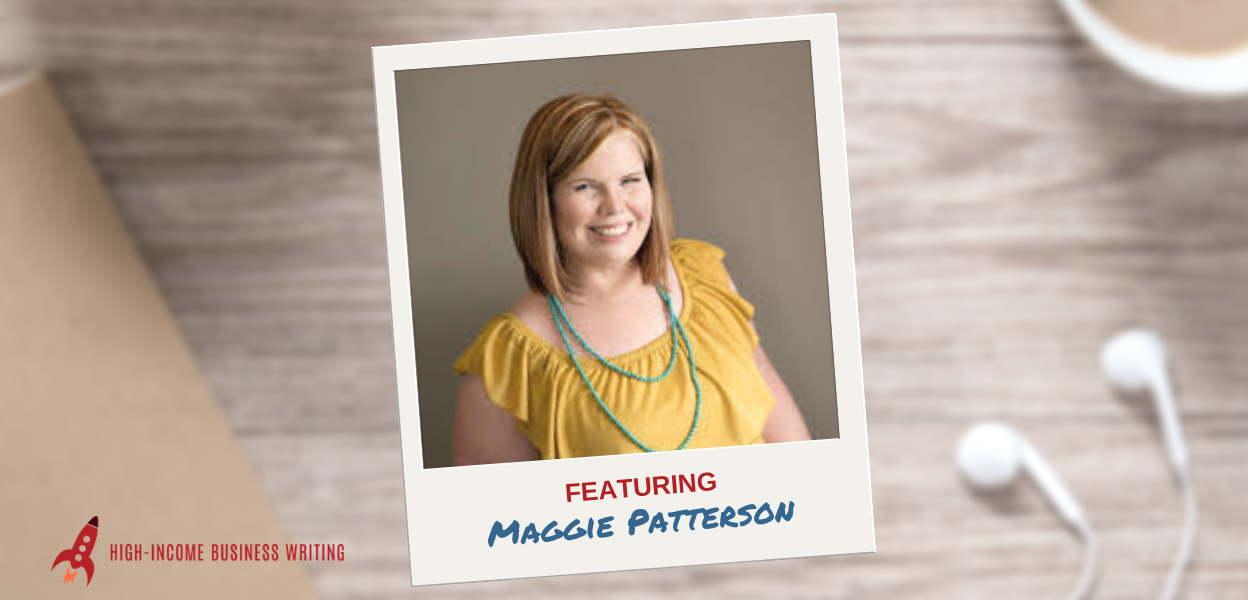Make no mistake … you can earn a very handsome income as a writer working on “transactional” assignments for clients.
For example, you could earn a very comfortable living writing $6,000 white papers for clients with recurring needs.
With just three or four repeat clients, you can stay booked solid. And as you get to know the client better, your internal hourly rate can skyrocket as you produce their content more efficiently.
But for some writers, this model can get old as they grow. They start to wonder if there’s a better way of doing things.
That’s exactly what happened to this week’s guest.
Maggie Patterson was making great money as a freelance writer. But she was starting to feel burned out.
So she started looking for ways to better differentiate herself from other writers AND get well compensated for her expertise.
She began to experiment with offering more comprehensive services that included proprietary processes.
And the idea took hold.
In this interview, Maggie explains how she transitioned from the traditional freelance model to an agency model, and how she leveraged a series of proprietary processes to separate herself from the competition … while delivering way more value to her clients.
The notes that follow are a very basic, unedited summary of the show. There’s a lot more detail in the audio version. You can listen to the show using the audio player below. Or you can subscribe in iTunes to get this show delivered straight to the Podcasts app on your smart phone, tablet or iPod.


High-Income Business Writing with Ed Gandia
#161: How Maggie Patterson Transformed Her Writing Business by Creating Premium Services Built Around Proprietary Processes
Tell us about your business today
Maggie Patterson owns a content marketing agency called Scoop Studios. The company serves a wide variety of clients, but mostly specializes in small and mid-size businesses.
How did you get your business to this point?
Thirteen years ago, Maggie was working for a PR agency. The hours were grueling, with lots of travel. She loved her job but ultimately wanted more flexibility for herself and her family.
When she left on maternity leave, she decided to start her freelance business. At the time, content marketing was growing, and she ended up doing less PR and more writing.
She worked freelance for eight years. Eventually, she shifted from a freelancer to a business owner mindset. She started to price her services differently and set boundaries.
In 2005, she and a contractor decided to go into business together, and Scoop Studios was born. Her partner eventually left for personal reasons.
Today, Maggie has a team of one full-time employee and a number of steady contractors.
As a result, she can now pick and choose how she spends her time.
Did you ever worry about having to manage people?
Definitely! At her agency job, Maggie was managing huge teams—so she knew the associated complications and hassles.
She has set up her team so that her full-time employee does a lot of the day-to-day management of contractors.
If you’re considering bringing on contractors, start small. Start by working with an assistant and see how it goes. Take baby steps so you can discover what works best for you and your business.
You use a different model to present and price your services. Tell us about your approach.
As a freelancer, Maggie had charged by the hour. She wanted to find a way to change that without having the client sit and calculate her internal hourly rate. So she created a signature process that formalizes and systemizes the work they do.
The model lets Maggie and her team take ownership of the process, instead of the client. It lets her price in a premium way and shifts her team from being a commodity service to being an expert resource.
We often assume that clients know what they want, but they often don’t. When they don’t, we end up doing a lot of uncompensated work.
Maggie’s process is a way of making the intangible feel more tangible.
Tell us about your signature process
Scoop Studios has a multi-step process that they follow for most services. It’s a way to figure out what the client really needs.
Often the client will ask for something specific, such as a blog post. But by going through their process, they can present the client with a more thoughtful, comprehensive solution.
What happens when a client says they don’t want to go through the process and just want something transactional?
Maggie uses this objection as a way to screen out prospective clients. Clients that want something purely transactional aren’t a great fit for them.
In these cases, the client is probably looking for a lower-value solution, and Maggie is happy to recommend them to someone else.
Do you communicate your process on your website?
Maggie used to layout the process steps on their website, but most corporate clients wouldn’t read them.
However, she still has detailed sales pages that she can refer clients to. Those pages clearly breakout the steps, pricing and what’s included.
At this stage in the sales process, clients will either be scared off by the price or more committed to buying.
Do you think this approach is better suited for certain types of work or certain markets?
It’s true that some marketing directors, for example, won’t be swayed by a proprietary process. However, that process still demonstrates your experience.
You can say, “Based on our experience, this is the process I would recommend”—and then you can amend the process as needed. But that doesn’t mean you revert back to the old model, where you skip those early consulting steps entirely.
You have to know where you’re willing to bend and where you’re not.
It’s natural to get excited about a new client and want to bend over backwards to get them on board. But when you abandon your non-negotiables to do that, you give up your power—and you end up feeling like an employee.
How can we move from a fixed fee model to your signature process model?
Start with one service. Start with the service that causes you the most pain. Where are the problem areas?
Take something you’re already doing, improve upon it and formalize it.
Tell us how you’re able to convert prospects into clients so well
1. Get them on the phone. After she’s pre-qualified them, Maggie gets prospects on the phone. She walks them through their process, overcomes objections and answers questions.
2.Send a proposal. Because the process is set, putting together a proposal is relatively easy.
By the time they say “yes,” clients know exactly what will happen. They feel well taken care of.
Today, Maggie closes 80-90% of these deals. She’s learned to qualify better and weed out potential clients that won’t be a good fit before getting to the call stage.
What do you talk about on these calls?
The purpose of the consult call is to talk about how you will work together. It’s not about strategy.
Maggie won’t give strategy away for free. Clients need to pay for it!
You can always say, “I need to understand more about your business before I can make any recommendations”—because it’s true!
What should we be mindful of so that this approach is received the right way?
1. Make sure you have a track record of results with the service you choose to formalize. Don’t try to magically create something out of thin air.
2. Don’t get overly process driven. The process should still feel personal. You need to strike a balance between fully personalized and cookie cutter.
Clients will love your service process if it makes things simpler and easier for them.
How can listeners learn more about you and your work?
Maggie Patterson’s podcast Small Business Boss
https://smallbusinessboss.co/podcast
Download a free guide to developing your own signature service
https://smallbusinessboss.co/signature
By the way … whenever you’re ready, here are 4 ways I can help you grow your freelance business:
1. Grab a free copy of my training class for writers who are new to freelancing.
It’s called “The 3 Magic Levers: How to Get Your Writing Business Off the Ground and Land Your First Paying Client.” — Click Here
2. Download a free copy of my book for ESTABLISHED writers/copywriters.
You’ll discover how to quickly and predictably reawaken dead leads, generate new client opportunities and convert not-yet-ready prospects into freelance writing clients. — Click Here
3. Join our “Get Better Clients Academy”
You’ll get a personalized action plan based on where you are today in your business. Plus all the tools, scripts, checklists, cheat sheets and templates you’ll need to escape feast-or-famine … grow your income … and land clients who love and respect you. — Click Here
4. Get your website DONE!
If you’ve been struggling to get your website done … or if you’re not happy with what you’ve got today… let my team and me build you a beautiful website for your writing business. We’ll do all the hard work! Email me at ed@b2blauncher.com … put “WEBSITE” in the subject line … and I’ll reply with the details.






